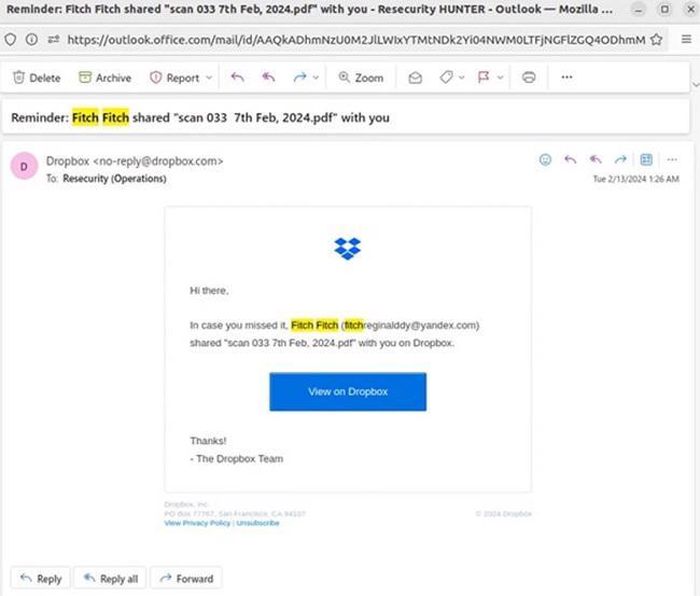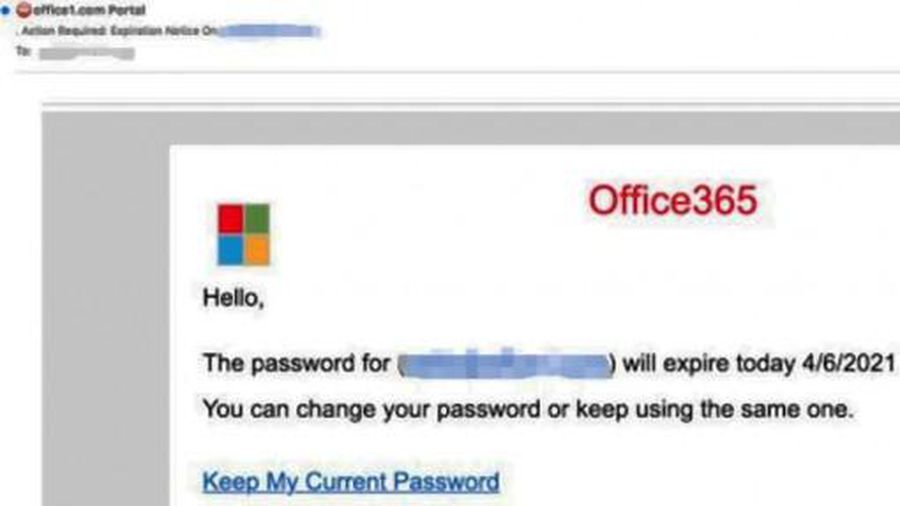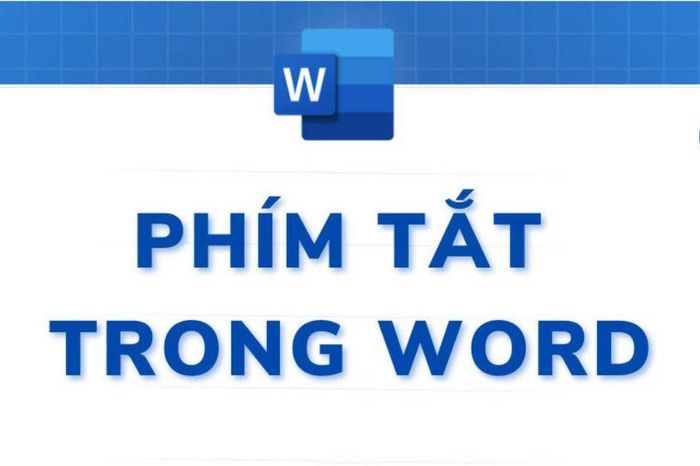Phishing campaign via email, abusing Microsoft Office templates to spread malicious code

According to researcher Ariel Davidpur, Operation PhantomBlu uses a very sophisticated exploitation method. Different from the normal NetSupport RAT distribution mechanism, it abuses interference with OLE (Object Linking and Embedding) templates, exploiting Microsoft Office document templates to execute malicious code.
NetSupport RAT is a malicious variant (malicious offshoot) of the legitimate remote computer access tool NetSupport Manager. NetSupport RAT allows threat actors to collect data from compromised devices.
The most common scenario for this attack is to start with a phishing email with the subject 'salary' to trick the recipient into opening the attached Microsoft Word document to view the monthly salary report.
The word file, when opened, will ask the victim to enter the password provided in the email body and allow editing, then double-click the printer icon in the document to view the salary chart.
This will open a ZIP file ("Chart20072007.zip") containing a Windows shortcut file. This file acts as a PowerShell tool that allows NetSupport RAT malware to be downloaded and executed from a remote server. From there, the subject will attack and commit acts of appropriation of property on the victim's device.
To minimize the risk of becoming a victim of such attack campaigns, users should always be vigilant when receiving strange emails, DO NOT access links or download/open attachments in emails IF this email is sent from an unreliable source or the email content has any suspicious elements.
Faced with information about the above international phishing campaign, the Department of Information Security (Ministry of Information and Communications) recommends that people be careful with files sent from unreliable sources or email content. suspect.
'It is necessary to carefully check the sender's email address and the content in the email; Do not arbitrarily click on any attachments or links in emails when you notice anything suspicious. Do not provide any personal or bank account information when requested to declare information from emails, recommended by the Department of Information Security.
In addition, users should use anti-virus software to scan email attachments. At the same time, pay attention to safety issues if using email when connecting to public wireless networks.
Besides, it is also important to note that you should not use one email for many Internet services, especially important services; Regularly change strong email passwords, do not leave default passwords; Set up two-layer security for email to authenticate with your phone so you can recover emails when attacked.
You should read it
- 4 things to expect in Microsoft Office 15
- Microsoft Office 16 exposes details in the new series
- Students and students enjoy free Office 365
- Microsoft Office 16 is coming soon
- Buy a Microsoft Office license at a 'bargain' price?
- Let Microsoft Office become more perfect
- Four reasons do not need to upgrade to new Microsoft Office
- Revealed Office Mix Preview, limited to registration
May be interested
- Warning: The new Facebook virus, a malicious code that is spreading rapidly through Messenger
 from yesterday (december 18, 2017), a new type of malicious code has appeared and raged in vietnam. this malicious code is not too sophisticated but is spreading very fast through facebook messenger because it is sent from the friends in the friend list.
from yesterday (december 18, 2017), a new type of malicious code has appeared and raged in vietnam. this malicious code is not too sophisticated but is spreading very fast through facebook messenger because it is sent from the friends in the friend list. - GIBON extortion code spread through spam
 a new ransomware called gibon, once again malspam (malware spread via email) attaches a malicious file and contains the download macro, installs the malicious code to blackmail the victim's computer.
a new ransomware called gibon, once again malspam (malware spread via email) attaches a malicious file and contains the download macro, installs the malicious code to blackmail the victim's computer. - Warning: New email phishing tactics appear
 hackers specializing in phishing email campaigns have always 'invented' new techniques to bypass popular security tools. email security solutions provider inky (usa) has just discovered three new phishing email campaigns that disguise the microsoft logo, but it is very difficult to stop.
hackers specializing in phishing email campaigns have always 'invented' new techniques to bypass popular security tools. email security solutions provider inky (usa) has just discovered three new phishing email campaigns that disguise the microsoft logo, but it is very difficult to stop. - Hackers break into chats on Microsoft Teams to spread malware
 international security researchers have just warned about a relatively new form of attack related to the traditional enterprise application platform microsoft teams.
international security researchers have just warned about a relatively new form of attack related to the traditional enterprise application platform microsoft teams. - Warning: Dangerous new malicious code spills over to Vietnam
 on the afternoon of february 14, bkav's virus surveillance system issued a warning about a w32.weakpass extortion encryption code-targeting campaign targeting vietnamese public servers of foreign hackers.
on the afternoon of february 14, bkav's virus surveillance system issued a warning about a w32.weakpass extortion encryption code-targeting campaign targeting vietnamese public servers of foreign hackers. - Trojans appear to resolve the Windows patch
 websense has just released a newsletter warning users about a phishing campaign that provides windows patches via new email launched in the past week.
websense has just released a newsletter warning users about a phishing campaign that provides windows patches via new email launched in the past week. - 4 tools to detect phishing emails
 email phishing is no longer as simple as it used to be. scammers are now tech-savvy criminals who leverage advanced tools to scam victims.
email phishing is no longer as simple as it used to be. scammers are now tech-savvy criminals who leverage advanced tools to scam victims. - Warning: New malicious code is infecting about 500,000 router devices
 cisco researchers have released a warning warning about a malicious malicious code called vpnfilter, which is spread by a group of hackers spreading more than 500,000 home or small companies' devices across the globe. world.
cisco researchers have released a warning warning about a malicious malicious code called vpnfilter, which is spread by a group of hackers spreading more than 500,000 home or small companies' devices across the globe. world. - [Infographic] 4 types of Phishing are easy to trap users
![[Infographic] 4 types of Phishing are easy to trap users](https://tipsmake.com/img/no-image-80-80.png) phishing often appears as a reliable activity by legitimate companies or a reputable electronic information site like ebay, paypal, gmail ..
phishing often appears as a reliable activity by legitimate companies or a reputable electronic information site like ebay, paypal, gmail .. - Warning malicious code is spread through email, there is a risk of losing all data
 the forms of intrusion and attack on user data are increasingly sophisticated disguised hacker groups. malware in addition to disguised under applications on the play store can be attached via e-mail messages.
the forms of intrusion and attack on user data are increasingly sophisticated disguised hacker groups. malware in addition to disguised under applications on the play store can be attached via e-mail messages.








![[Infographic] 4 types of Phishing are easy to trap users](https://tipsmake.com/data/thumbs_80x80/[infographic]-4-types-of-phishing-are-easy-to-trap-users_thumbs_80x80_q5IK2um5z.jpg)

 Instructions on how to break columns in Word simply and quickly
Instructions on how to break columns in Word simply and quickly Show you how to create your own shortcuts in Word very simply
Show you how to create your own shortcuts in Word very simply Learn what is Outline in Word and the fastest way to use it?
Learn what is Outline in Word and the fastest way to use it? Instructions on how to display lines in Word are extremely simple
Instructions on how to display lines in Word are extremely simple Extremely simple instructions on how to fill in blank cells with 0 in Excel
Extremely simple instructions on how to fill in blank cells with 0 in Excel Introducing how to use the CONVERT function in Excel in the most detail
Introducing how to use the CONVERT function in Excel in the most detail